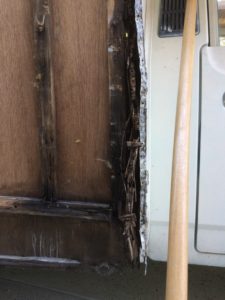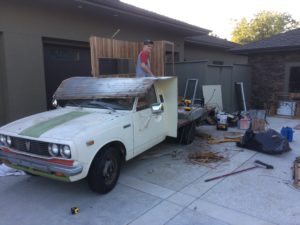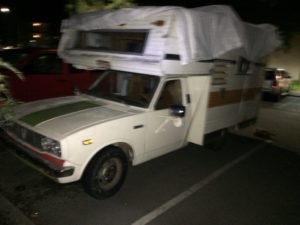The only changes I made to the design were following its original angle at the overcab back 3/4 of the length of the structure. This created A LOT more head room and will hopefully make it easier for snow to slide off, a situation I hope to find myself in with this regularly. Here’s a couple preliminary design ideas.

I ended up sort of combining the two designs, taking the roof line from the top drawing for previously stated reasons and using two materials transitioning at the window/overcab line like in the bottom design. The use of multiple materials was mostly due to concerns about weight and partly concerns about not having enough material to run redwood all the way up. I had originally thought to use reclaimed corrugated metal roofing but that stuff is rather hard to come by at a reasonable price and the logistics of placing windows and doors as well as how it would look with a metal roof eventually lead me to abandon that idea.
Instead, when I found a guy through OfferUp selling a gorgeous (albeit heavy) 2′ x 4′ skylight for $20 that fit my vision of staring at the stars from bed perfectly, he also happened to be selling just enough square footage of unused off-white cape cod shingle looking vinyl siding to cover the top half of the rig. When I got it home it matched the cab paint perfectly… and at the cost of only another Jackson it was perfect. Lightweight, kitchy, easy to cut and assemble… too perfect!
But first, I still had to build the walls back up which, as most things with this project, proved to be more difficult that originally expected. However, using the previous framework as a reference made the work go faster and with a little help from family and friends we had a “tiny house truck” raising and got all the walls up, stapled and screwed them together and before a stiff breeze had the chance to blow all my toothpicks away we wrapped it up in moisture barrier.
The next step was stacking the wood strips I had ripped out of old redwood decking against the bottom half of the bae. It was at this point the fruits began to look like they might bare as I began to see the image I had held in my mind for nearly a year become real before my eyes.



with both sides and the rear planked up it was time to get this eyesore off my boss/friend’s driveway before the HOA started fining their asses. I owe him, his wife, and their whole family a huge debt for all the help that they’ve given me with project and innumerable other instances of graciousness, I doubt I’ll ever be able to repay it. Before I made the drive I had to snap a quick shot of a couple vinyl siding pieces dry fit to see how it’d look and I must say, not too shabby for a truck shack.























